Jiahao Yang
Physics-Driven Spatiotemporal Modeling for AI-Generated Video Detection
Oct 09, 2025Abstract:AI-generated videos have achieved near-perfect visual realism (e.g., Sora), urgently necessitating reliable detection mechanisms. However, detecting such videos faces significant challenges in modeling high-dimensional spatiotemporal dynamics and identifying subtle anomalies that violate physical laws. In this paper, we propose a physics-driven AI-generated video detection paradigm based on probability flow conservation principles. Specifically, we propose a statistic called Normalized Spatiotemporal Gradient (NSG), which quantifies the ratio of spatial probability gradients to temporal density changes, explicitly capturing deviations from natural video dynamics. Leveraging pre-trained diffusion models, we develop an NSG estimator through spatial gradients approximation and motion-aware temporal modeling without complex motion decomposition while preserving physical constraints. Building on this, we propose an NSG-based video detection method (NSG-VD) that computes the Maximum Mean Discrepancy (MMD) between NSG features of the test and real videos as a detection metric. Last, we derive an upper bound of NSG feature distances between real and generated videos, proving that generated videos exhibit amplified discrepancies due to distributional shifts. Extensive experiments confirm that NSG-VD outperforms state-of-the-art baselines by 16.00% in Recall and 10.75% in F1-Score, validating the superior performance of NSG-VD. The source code is available at https://github.com/ZSHsh98/NSG-VD.
EVA-MILP: Towards Standardized Evaluation of MILP Instance Generation
May 30, 2025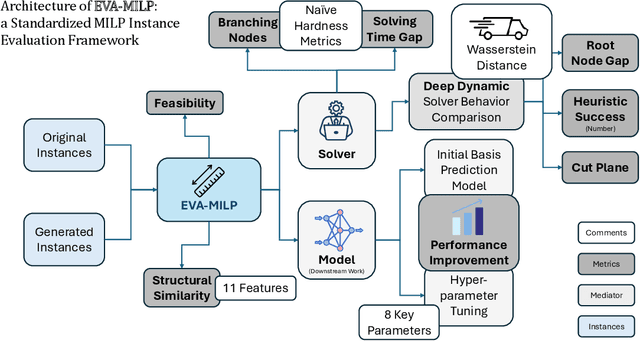
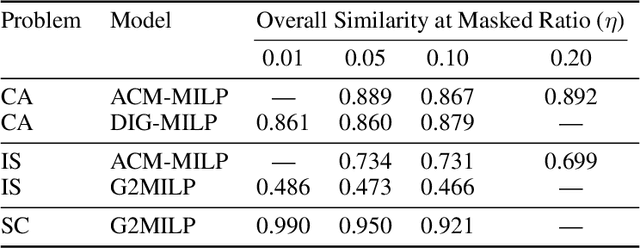
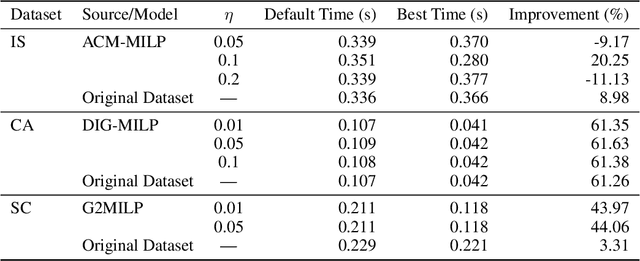
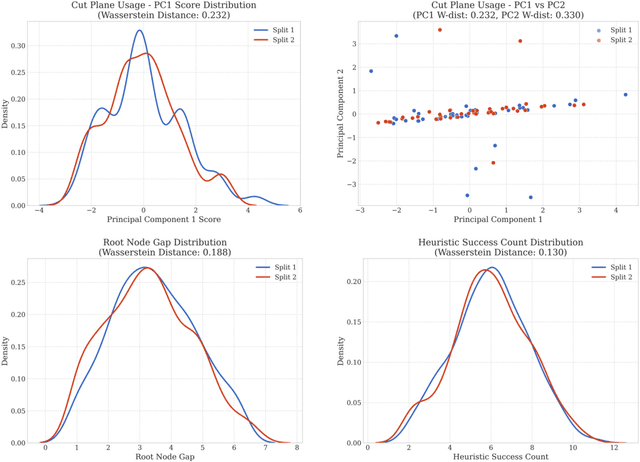
Abstract:Mixed-Integer Linear Programming (MILP) is fundamental to solving complex decision-making problems. The proliferation of MILP instance generation methods, driven by machine learning's demand for diverse optimization datasets and the limitations of static benchmarks, has significantly outpaced standardized evaluation techniques. Consequently, assessing the fidelity and utility of synthetic MILP instances remains a critical, multifaceted challenge. This paper introduces a comprehensive benchmark framework designed for the systematic and objective evaluation of MILP instance generation methods. Our framework provides a unified and extensible methodology, assessing instance quality across crucial dimensions: mathematical validity, structural similarity, computational hardness, and utility in downstream machine learning tasks. A key innovation is its in-depth analysis of solver-internal features -- particularly by comparing distributions of key solver outputs including root node gap, heuristic success rates, and cut plane usage -- leveraging the solver's dynamic solution behavior as an `expert assessment' to reveal nuanced computational resemblances. By offering a structured approach with clearly defined solver-independent and solver-dependent metrics, our benchmark aims to facilitate robust comparisons among diverse generation techniques, spur the development of higher-quality instance generators, and ultimately enhance the reliability of research reliant on synthetic MILP data. The framework's effectiveness in systematically comparing the fidelity of instance sets is demonstrated using contemporary generative models.
FaceEditTalker: Interactive Talking Head Generation with Facial Attribute Editing
May 28, 2025Abstract:Recent advances in audio-driven talking head generation have achieved impressive results in lip synchronization and emotional expression. However, they largely overlook the crucial task of facial attribute editing. This capability is crucial for achieving deep personalization and expanding the range of practical applications, including user-tailored digital avatars, engaging online education content, and brand-specific digital customer service. In these key domains, the flexible adjustment of visual attributes-such as hairstyle, accessories, and subtle facial features is essential for aligning with user preferences, reflecting diverse brand identities, and adapting to varying contextual demands. In this paper, we present FaceEditTalker, a unified framework that enables controllable facial attribute manipulation while generating high-quality, audio-synchronized talking head videos. Our method consists of two key components: an image feature space editing module, which extracts semantic and detail features and allows flexible control over attributes like expression, hairstyle, and accessories; and an audio-driven video generation module, which fuses these edited features with audio-guided facial landmarks to drive a diffusion-based generator. This design ensures temporal coherence, visual fidelity, and identity preservation across frames. Extensive experiments on public datasets demonstrate that our method outperforms state-of-the-art approaches in lip-sync accuracy, video quality, and attribute controllability. Project page: https://peterfanfan.github.io/FaceEditTalker/
MatchDance: Collaborative Mamba-Transformer Architecture Matching for High-Quality 3D Dance Synthesis
May 21, 2025Abstract:Music-to-dance generation represents a challenging yet pivotal task at the intersection of choreography, virtual reality, and creative content generation. Despite its significance, existing methods face substantial limitation in achieving choreographic consistency. To address the challenge, we propose MatchDance, a novel framework for music-to-dance generation that constructs a latent representation to enhance choreographic consistency. MatchDance employs a two-stage design: (1) a Kinematic-Dynamic-based Quantization Stage (KDQS), which encodes dance motions into a latent representation by Finite Scalar Quantization (FSQ) with kinematic-dynamic constraints and reconstructs them with high fidelity, and (2) a Hybrid Music-to-Dance Generation Stage(HMDGS), which uses a Mamba-Transformer hybrid architecture to map music into the latent representation, followed by the KDQS decoder to generate 3D dance motions. Additionally, a music-dance retrieval framework and comprehensive metrics are introduced for evaluation. Extensive experiments on the FineDance dataset demonstrate state-of-the-art performance. Code will be released upon acceptance.
STaR: Seamless Spatial-Temporal Aware Motion Retargeting with Penetration and Consistency Constraints
Apr 09, 2025Abstract:Motion retargeting seeks to faithfully replicate the spatio-temporal motion characteristics of a source character onto a target character with a different body shape. Apart from motion semantics preservation, ensuring geometric plausibility and maintaining temporal consistency are also crucial for effective motion retargeting. However, many existing methods prioritize either geometric plausibility or temporal consistency. Neglecting geometric plausibility results in interpenetration while neglecting temporal consistency leads to motion jitter. In this paper, we propose a novel sequence-to-sequence model for seamless Spatial-Temporal aware motion Retargeting (STaR), with penetration and consistency constraints. STaR consists of two modules: (1) a spatial module that incorporates dense shape representation and a novel limb penetration constraint to ensure geometric plausibility while preserving motion semantics, and (2) a temporal module that utilizes a temporal transformer and a novel temporal consistency constraint to predict the entire motion sequence at once while enforcing multi-level trajectory smoothness. The seamless combination of the two modules helps us achieve a good balance between the semantic, geometric, and temporal targets. Extensive experiments on the Mixamo and ScanRet datasets demonstrate that our method produces plausible and coherent motions while significantly reducing interpenetration rates compared with other approaches.
HandSplat: Embedding-Driven Gaussian Splatting for High-Fidelity Hand Rendering
Mar 18, 2025Abstract:Existing 3D Gaussian Splatting (3DGS) methods for hand rendering rely on rigid skeletal motion with an oversimplified non-rigid motion model, which fails to capture fine geometric and appearance details. Additionally, they perform densification based solely on per-point gradients and process poses independently, ignoring spatial and temporal correlations. These limitations lead to geometric detail loss, temporal instability, and inefficient point distribution. To address these issues, we propose HandSplat, a novel Gaussian Splatting-based framework that enhances both fidelity and stability for hand rendering. To improve fidelity, we extend standard 3DGS attributes with implicit geometry and appearance embeddings for finer non-rigid motion modeling while preserving the static hand characteristic modeled by original 3DGS attributes. Additionally, we introduce a local gradient-aware densification strategy that dynamically refines Gaussian density in high-variation regions. To improve stability, we incorporate pose-conditioned attribute regularization to encourage attribute consistency across similar poses, mitigating temporal artifacts. Extensive experiments on InterHand2.6M demonstrate that HandSplat surpasses existing methods in fidelity and stability while achieving real-time performance. We will release the code and pre-trained models upon acceptance.
Adversarial Purification by Consistency-aware Latent Space Optimization on Data Manifolds
Dec 11, 2024



Abstract:Deep neural networks (DNNs) are vulnerable to adversarial samples crafted by adding imperceptible perturbations to clean data, potentially leading to incorrect and dangerous predictions. Adversarial purification has been an effective means to improve DNNs robustness by removing these perturbations before feeding the data into the model. However, it faces significant challenges in preserving key structural and semantic information of data, as the imperceptible nature of adversarial perturbations makes it hard to avoid over-correcting, which can destroy important information and degrade model performance. In this paper, we break away from traditional adversarial purification methods by focusing on the clean data manifold. To this end, we reveal that samples generated by a well-trained generative model are close to clean ones but far from adversarial ones. Leveraging this insight, we propose Consistency Model-based Adversarial Purification (CMAP), which optimizes vectors within the latent space of a pre-trained consistency model to generate samples for restoring clean data. Specifically, 1) we propose a \textit{Perceptual consistency restoration} mechanism by minimizing the discrepancy between generated samples and input samples in both pixel and perceptual spaces. 2) To maintain the optimized latent vectors within the valid data manifold, we introduce a \textit{Latent distribution consistency constraint} strategy to align generated samples with the clean data distribution. 3) We also apply a \textit{Latent vector consistency prediction} scheme via an ensemble approach to enhance prediction reliability. CMAP fundamentally addresses adversarial perturbations at their source, providing a robust purification. Extensive experiments on CIFAR-10 and ImageNet-100 show that our CMAP significantly enhances robustness against strong adversarial attacks while preserving high natural accuracy.
Sim-to-Real Transfer via 3D Feature Fields for Vision-and-Language Navigation
Jun 14, 2024



Abstract:Vision-and-language navigation (VLN) enables the agent to navigate to a remote location in 3D environments following the natural language instruction. In this field, the agent is usually trained and evaluated in the navigation simulators, lacking effective approaches for sim-to-real transfer. The VLN agents with only a monocular camera exhibit extremely limited performance, while the mainstream VLN models trained with panoramic observation, perform better but are difficult to deploy on most monocular robots. For this case, we propose a sim-to-real transfer approach to endow the monocular robots with panoramic traversability perception and panoramic semantic understanding, thus smoothly transferring the high-performance panoramic VLN models to the common monocular robots. In this work, the semantic traversable map is proposed to predict agent-centric navigable waypoints, and the novel view representations of these navigable waypoints are predicted through the 3D feature fields. These methods broaden the limited field of view of the monocular robots and significantly improve navigation performance in the real world. Our VLN system outperforms previous SOTA monocular VLN methods in R2R-CE and RxR-CE benchmarks within the simulation environments and is also validated in real-world environments, providing a practical and high-performance solution for real-world VLN.
MoFormer: Multi-objective Antimicrobial Peptide Generation Based on Conditional Transformer Joint Multi-modal Fusion Descriptor
Jun 03, 2024



Abstract:Deep learning holds a big promise for optimizing existing peptides with more desirable properties, a critical step towards accelerating new drug discovery. Despite the recent emergence of several optimized Antimicrobial peptides(AMP) generation methods, multi-objective optimizations remain still quite challenging for the idealism-realism tradeoff. Here, we establish a multi-objective AMP synthesis pipeline (MoFormer) for the simultaneous optimization of multi-attributes of AMPs. MoFormer improves the desired attributes of AMP sequences in a highly structured latent space, guided by conditional constraints and fine-grained multi-descriptor.We show that MoFormer outperforms existing methods in the generation task of enhanced antimicrobial activity and minimal hemolysis. We also utilize a Pareto-based non-dominated sorting algorithm and proxies based on large model fine-tuning to hierarchically rank the candidates. We demonstrate substantial property improvement using MoFormer from two perspectives: (1) employing molecular simulations and scoring interactions among amino acids to decipher the structure and functionality of AMPs; (2) visualizing latent space to examine the qualities and distribution features, verifying an effective means to facilitate multi-objective optimization AMPs with design constraints
Lookahead Exploration with Neural Radiance Representation for Continuous Vision-Language Navigation
Apr 02, 2024
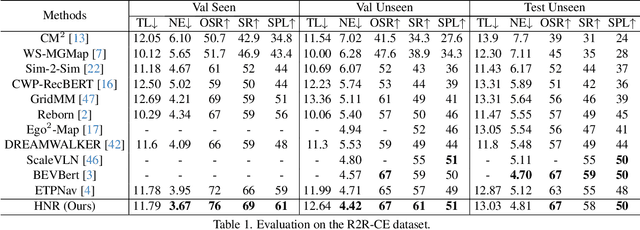


Abstract:Vision-and-language navigation (VLN) enables the agent to navigate to a remote location following the natural language instruction in 3D environments. At each navigation step, the agent selects from possible candidate locations and then makes the move. For better navigation planning, the lookahead exploration strategy aims to effectively evaluate the agent's next action by accurately anticipating the future environment of candidate locations. To this end, some existing works predict RGB images for future environments, while this strategy suffers from image distortion and high computational cost. To address these issues, we propose the pre-trained hierarchical neural radiance representation model (HNR) to produce multi-level semantic features for future environments, which are more robust and efficient than pixel-wise RGB reconstruction. Furthermore, with the predicted future environmental representations, our lookahead VLN model is able to construct the navigable future path tree and select the optimal path via efficient parallel evaluation. Extensive experiments on the VLN-CE datasets confirm the effectiveness of our method.
 Add to Chrome
Add to Chrome Add to Firefox
Add to Firefox Add to Edge
Add to Edge